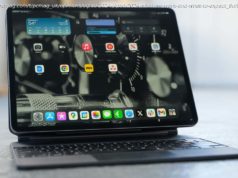Asus is doubling down on making a laptop’s touch screen serve double duty as a second display. The company announced ScreenPad support for the Asus ZenBook Pro 14 at IFA.
BERLIN—One of the coolest things about the Asus ZenBook Pro 15 is that its touchpad doubles as a second, tiny touch-screen display called the ScreenPad. The idea is cool, but the execution leaves a bit to be desired: The ScreenPad doesn’t really work as a touch screen and it’s a bit cumbersome to use as an extension of the laptop’s main display.
At the IFA consumer tech trade show here, Asus announced a potential fix for those issues and an expansion of its ScreenPad display to a new laptop, the Asus ZenBook Pro 14.
The expansion signifies that the ScreenPad is more than a gimmick to Asus. More importantly, it’s an indication that Asus laptops of all sizes, battery capacities, and computing prowesses could one day make use of them. For now, adding another ScreenPad-equipped model amounts to a doubling of the current offerings.
My quick look at the ScreenPad improvements at IFA left me quite impressed; so much so that if you’re eyeing the ZenBook Pro 15 specifically for its ScreenPad, I’d recommend waiting until the ZenBook Pro 14 goes on the market this fall.
The two biggest improvements are software-related. There’s a new translucent dot that now appears constantly when the ScreenPad is turned on. Tap it to reveal three options. The first, Touch Mode, lets you toggle between using the ScreenPad to control the mouse cursor and using it to tap on-screen elements the way you might if you’ve ever used a Windows touch-screen laptop before.
This is a big improvement. For instance, if you want to close an app window that’s displayed on the ScreenPad, you used to have to drag the cursor over to the Close button in the upper-right corner and then tap it, which is no small feat on such a tiny screen. Now all you have to do is tap on the Close button.
The second new option is Window Down. Tap it and whatever app is currently displayed on the laptop’s main screen will instantly reappear perfectly resized on the ScreenPad. This eliminates a lot of awkward dragging with your pointer finger to move app windows between displays.
In addition to the ScreenPad improvements, I also enjoyed using the 14-inch ZenBook Pro 14 far more than I did its larger brother, the 15-inch ZenBook Pro 15. Not only is it smaller and lighter, but it also looks far more stylish with a perforated gold metal bar above the keyboard. There’s also a nifty ErgoLift hinge that tilts the back part of the keyboard up when it’s open. (Anecdotally, I find the raised keyboard to be less comfortable than a flat one, but I think the raised board looks better).
The ZenBook Pro 14 also features the same excellent, sturdy keys as its big brother. Many of the other niceties, like an Nvidia GeForce GTX 1050 Ti graphics card and a superbly rich, colorful main display, are also shared by the Pro 15. The only feature missing is the Intel Core i9, which undoubtedly produces too much heat to be stuffed into the ZenBook Pro 14’s smaller chassis. Asus didn’t reveal pricing for the US version of the laptop.
In addition to the new ScreenPad-equipped ZenBook Pro 14, Asus also revamped its ZenBook Flip, ZenBook, and ZenBook S lineups at IFA. The ZenBook S, a 2.2-pound ultraportable with a 13.3-inch display, gets new Intel Core processors that promise up to 20 hours of battery life.
Meanwhile, the ZenBooks and ZenBook Flips get slimmer and lighter thanks to new slimmer borders around their displays, known as bezels. The 13-inch ZenBook 13 now has a 95 percent screen-to-body ratio, slightly besting the 91 percent ratio of the Huawei MateBook X Pro.
Pricing and availability for the US versions of the new ZenBooks weren’t available at press time.






